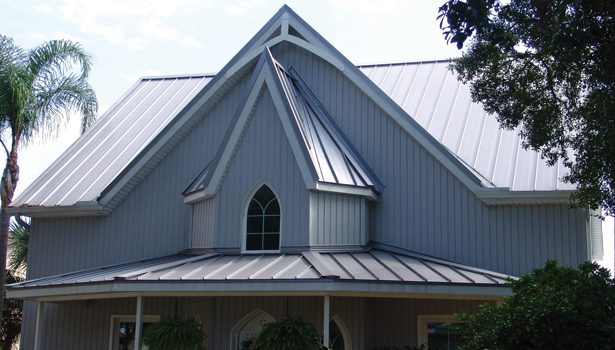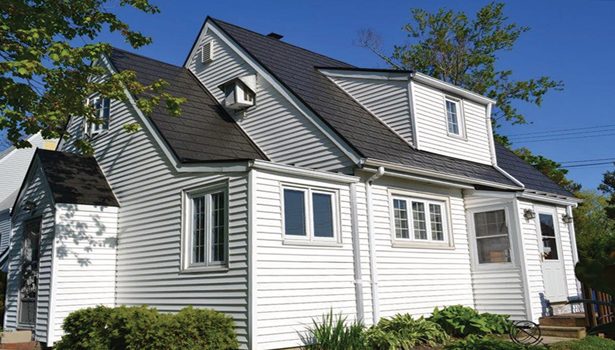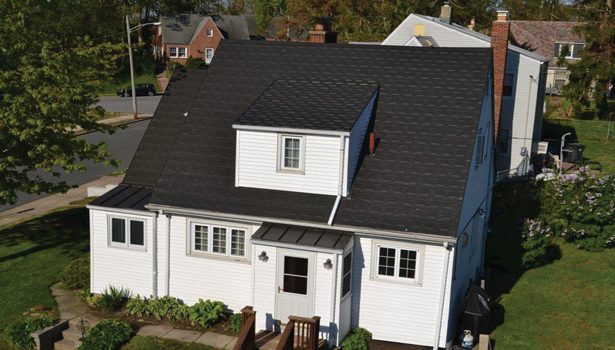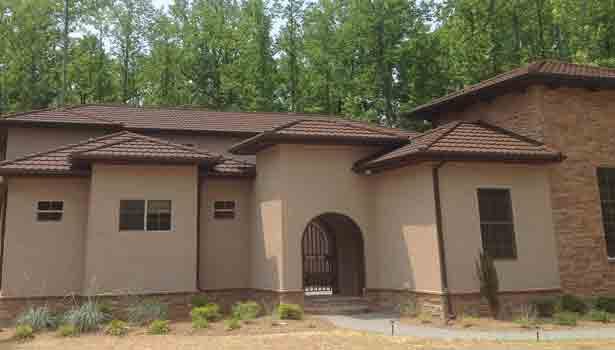Prepainted Metal Roofs Increase in Popularity, Add Benefits for Homeowners








More than seven million homeowners in North America each year are faced with the decision to replace a worn-out or leaky roof, and most still choose traditional roofing materials on the recommendation of contractors, neighbors and family. Garnering more attention since the year 2000, however, is a migration toward prepainted metal roofs.
There is a growing list of reasons for the expanding use of metal roofs in the residential market. Leading the list is the tremendous variety of shapes and colors that today’s metal roof offers. Besides the aesthetic advantages, modern metal residential roofing is easily installed and offers longevity, energy savings and durability, even under extreme weather conditions.
Metal roofs can be formed and prepainted to simulate traditional roofing materials, such as asphalt shingles, cedar shake, tile or even slate. Advancements in coil coating technology now make it possible for prepainted metals roofs to feature many different linear and multi-dimensional looks to complement other homes in the neighborhood.
A variety of environmental benefits are also attributed to the rise in prepainted metal roofs. “Cool” infrared pigment technology is specifically designed to reflect heat, helping to reduce energy needs and mitigate environmental problems like urban heat islands and smog.
“About 10% of those seven million households are choosing metal roofs today, and that number is expected to climb to 20% by the year 2020,” observes Bill Hippard, President of the Metal Roofing Alliance and also a member of the National Coil Coating Association (NCCA). “Those numbers translate into nearly 700,000 tons of metal getting prepainted and formed into residential roofs each year.”
“Our industry is on a major consumer marketing campaign to educate homeowners and home improvement contractors on the advantages of metal roofing,” notes Hippard, whose full-time job is Vice President of Sales for St. Louis-based Precoat Metals. “One issue homeowners have is how their new metal roof will fit into the neighborhood. With the advancements in printing capabilities through coil coating, we can match any style or texture found on a traditional roof, so a metal roof can blend right into the neighborhood.”
The Right Roof Makes a Difference
The “sweet spot” of the metal roof market is those homes with a steep-pitched roof, which better shows off the vibrant colors and textures as opposed to a flatter roof, according to Dick Bus, board member of the Metal Roofing Alliance and another member of the NCCA. “A low-slope roof is not visible from the ground, so you lose that striking effect that comes with a metal roof,” Bus notes. “Homes with a steep-pitched roof are ideal for metal, and then you can also tie in metal wall panels for a more dramatic look.”
Bus likes to refer to metal roofs as “high-performance roofing systems” because of their durability and lack of maintenance. “A properly installed metal roof will last 40-50 years and, with certain coatings, metal roofs are brighter and stay cleaner longer,” says Bus, President of ATAS International Inc., based in Allentown, PA.
ATAS, for example, offers 30 standard colors and 20 metal roof styles available in aluminum, steel, zinc and copper. The styles include standing seam and batten seams, corrugated, curved, tapered, shingles, tiles, shakes, and narrow- and wide-ribbed panels with hidden or exposed fasteners. Rainware and perimeter edge trim are also available with the same finish to match or accent a metal roofing or metal wall system.
Multiple Steps in Metal Roof Fabrication
Residential metal roofing is primarily made of steel or aluminum. Cooper and zinc are also used in specialized applications for homes. Metal roofing is very lightweight with the heaviest product weighing about 1½ pounds per square foot when installed and is generally in the 24-26 gauge range, with the higher gauge being thinner than the lower.
Metal roofs are initially produced in giant coils in the mills. The coils are coated with a metallic coating to prevent rust at the steel plant. From there, the coils are transported to a coil coating operation. In one continuous process, the coil of metal, up to 72” wide moving up to 700 feet per minute, is unwound, cleaned on both top and bottom, chemically treated, primed, oven cured, top coated, oven cured again, rewound and prepared for shipment.
The coil coating process itself is considered the most environmentally responsible way to apply paint to steel and aluminum substrate. That’s because coil coating is a highly efficient closed-loop process. The curing ovens burn harmful VOCs, using them as fuel, which saves energy and eliminates pollutants that would otherwise be released into the air.
Dealing with a flat (unwound) sheet allows for mechanical cleaning in addition to spray cleaning. The flat sheet also enables excellent control of coating weights of the pretreatment and the dry film thickness of paint to within a tenth of a mil or less to insure consistent color and quality from coil to coil.
The painted coil is then shipped to a roofing manufacturer where it is formed into long panels by a roll-forming process or the coil is stamped into individual shingles using large presses. Accessory shapes used for the roofing, gutters, downspouts and rain ware are also formed at this time.
Aluminum residential roofing follows the same process except it does not require the metallic coating step. Aluminum roofing is designated by decimal thickness and ranges from .023 to .040 thicknesses, according to the Metal Roofing Alliance.
Benefits of Metal Roofing Add up
Hippard, from the Metal Roof Alliance, claims that interest is high both at the homeowner end and at the roofer and design-professional level. Most homeowners and property owners are willing to pay a little more to achieve the right look, professional level, return on investment and warranty for their home.
“The cost to install a metal roof is about twice that of an asphalt roof, but the ROI is amazing,” notes Hippard. “Two key things are the energy savings and environmental benefits you get right off the bat with a metal roof,” say Hippard. “Because metal roofs are coated with high reflective pigments, they reflect off a significant portion of heat. Some homeowners can save 15% to 40% off their air conditioning bills in the summer.”
Durability is another key to upswing in metal roof installations, according to the Metal Roof Alliance. In most cases, a metal roof can withstand decades of abuse from extreme weather like hail, high winds and heavy snow. Today’s systems also have a 150-MPH wind rating (equal to an F2 tornado), meaning metal roofs are safe from wind gusts that can accompany hail storms.
Looking for a reprint of this article?
From high-res PDFs to custom plaques, order your copy today!








